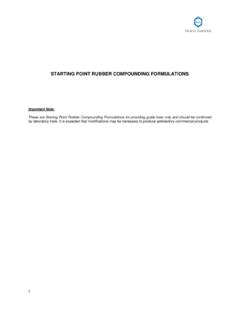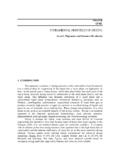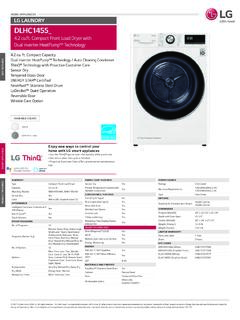Transcription of Technical Note: NR-Latex & Latex Products
1 1 Technical Note: NR- Latex & Latex Products Rubber Latex is a stable dispersion of polymeric substances in aqueous medium and is essentially a two phase system; 1) Disperse phase (discontinuous phase of rubber molecules) & 2) Dispersion medium (aqueous continuous phase of serum). Basically there are two types of lattices viz. Natural lattices and Synthetic lattices. Natural Rubber Latex (NR Latex ) is the most widely used Latex for the manufacture of Latex based rubber Products . Fundamental characteristics of lattices Lattices are complex colloid systems containing polymer molecules as major fraction. The polymer may be a homo polymer or co-polymer (random / block / graft). Stereo regularity and the complexity of the polymer molecules (linear / branched / cross linked) is maintained in the Latex form.
2 The avg-molecular size, molecular weight & molecular weight distribution of the Latex depend on the grade selected. Lattices are rubbery or resinous in nature and the rubber molecules can be cross linked. Lattices can be plasticized or oil extended. Lattices have their own mechanical properties and temperature limits of serviceability. The rubber particle is generally oval having < 5 micron particle size and a typical particle size distribution. The aqueous phase consists of dissolved and suspended matters and knowledge of their concentration, acidic / basic nature (pH) is essential for successful Latex compounding. Latex Products are subject to degradation and adequate antioxidant protection is necessary. NR- Latex Over 200 species of plants are found to yield NR Latex on tapping.
3 Only Hevea Brasiliensis plant is of commercial importance and accounts for 99% of World s NR production. On tapping the Hevea brasiliensis tree, NR- Latex exudes. Composition of field Latex : Material % By weight Total solids contents (TSC) 36 Dry rubber contents (DRC) 25-40 Proteins substances Resinous substances Ash Up to Sugars Up to Water Balance Two surface phases are present in Latex viz. air aqueous phase interface (surface free energy of Latex ) and an aggregate of polymer-aqueous phase (Stability / Change). The manner in which surface-active substances are distributed in the two phases is of great significance for product manufacture. The Dispersed Phase (NR): Consists of small (approximately < 5 diameter) polymeric particles dispersed in serum with - ve surface charge (anions). Typical composition of the disperse phase is as follows: 2 Material % by weight Rubber hydrocarbon 86 Water (dispersed in rubber hydrocarbon) 10 Portentous material 1 Lipid substances 3 Trace metals (Mg, K, Cu etc.)
4 ---------------------------------------- ---------------------------------------- --- Density of rubber particles = g/cc Chemical composition : Cis-1, 4 polyisoprene Chemical structure: Number avg. : Approx. = 300,000. Degree of polymerization: Approx. = 5000. Predominantly a cis configuration (all -CH3 groups on same side). Some evidence of presence of oxygen in the form of carbonyl groups, which cause hardening of NR on, prolonged storage. Also contains some peroxides, which form redox systems with other constituents causing cross linking and chain scission. Protein content is in the form of adsorbed layer, which surrounds the external surface of NR particles (protein is -globulin dissolved in the serum). Protein determines the charge (the electrophoresis characterization and coacervation behavior).
5 Lipids comprise of sterols and sterol esters ( ), wax and phospholipids adsorbed on rubber particles through which the proteins are anchored on rubber particles and are dissolved in the rubber hydrocarbon. The gel content (solvent insoluble rubber) steadily increases, as Latex is stored. (After 2 to 3 months the gel content in toluene is as high as 50% (process similar to storage hardening of NR, which takes its Mooney viscosity to 80-100). The Aaqueous Phase: The aqueous phase is a dilute solution of density g/cc & contains dissolved chemicals such as: Carbohydrates = approx. 1% ( ) methyl inositol) Proteins = approx. 1% ( -globulin, 200,000; Hevein, 10,000 & few others) Amino acids = approx (glycine, tyrocin, & 12 others) Free nitrogenous bases, methylamine Organic acids (other than amino acids) Metal ions, (K, Mg, Fe, Na, Cu etc.)
6 Complex enzymes CH2CH3 CCHCH2CH2CH3 CCHCH2 3 The predominant CATION present in NR Latex is Ammonium (NH4+) although serum also contains significant (25-35%) of Potassium cations. Following table summarizes avg. anion concentrations found in the serum of matured NR Latex . Anions % HA- Latex LA-TZ Latex Carbonate Acetate Malate Succinate Citrate Formate -glycerophosphate Glucose-t-phosphate Phosphate Oxalate Chloride Sulphate Hydroxide Propionate - Adsorbed non-rubber materials: Protein-lipid complexes: Lipids hydrolyze releasing fatty acid soaps which improve the mechanical stability of NR- Latex . High proportions of phospholipids & Furanoid acid representing total fatty acids play role in Latex stabilization.
7 Anions of various types behave differently towards zinc-ammine ions, which are major cause of NR Latex destabilization. NR- Latex Properties: - Whitish fluid, Density = - pH = - Surface free energy = 40-45 ergs/cm2 - Rubber particles = 35 % by weight - Aqueous phase = 55 % by weight - Lutoid phase = 10 % by weight. - Rubber phase = 25 35 % by weight (typical = 33 %). - Difference between TSC and DRC = 3 %. - Rubber particle size between 200-2000 A. (10 A = 1m = 1/103 = 1/10 7cm), - Rubber particles are negatively (- ve) charged Anions. Particle Size Distribution: Wide range of diameter: to ( ) Particle size distribution is fairly consistent, Synthetic rubber lattices have much lower particle size than NR- Latex . 4 Viscosity: Latex containing more than 25% by volume of disperse phase is a non-Newtonian fluid.
8 Hence the measured viscosity is dependant on the rate of shear rates, Brookfield viscosity at 6 rpm : = 180 Brookfield viscosity at 60 rpm : = 6/60 = Preservation of NR Latex : High Ammonia NR Latex : NR- Latex coagulates within few hours due to development of acidity through micro-organisms when the pH falls to around Ammonia at % is required for long term preservation. Ammonia also acts as a bactericide and sequestering agent for Mg++ and PO4 - - - ions. [The disadvantages of ammonia are that: It has a strong odor, It is expensive, Ammonia preserved Latex undergoes marked thickening when compounded with ZnO, It interferes with the gelation of Latex foam compound by Sodium Silicofluoride (SSF).]
9 (Excess ammonia has to be driven off before the Latex is used for compounding.)] Low Ammonia NR- Latex : Zinc Dialkyl dithiocarbamates (ZDMC / ZDEC) at % along with % ammonia and % lauric acid enhance the stability of NR- Latex to the level of ammonia preserved Latex without any significant effect on vulcanization. However, the Latex may give deposits that discolor badly on ageing (copper staining). Boric acid at with & lauric acid is most popular LA- Preservative system. (Precaution: boric acid increases the KOH number by units). The deposits are free from discoloration and boric acid is cheap, harmless to human beings, easy to handle and can be estimated accurately. However the unvulcanized deposits tend to soften faster. Sodium Pentachlorophenate at with ammonia is used as a stabilizer but not popular due to toxicity problems associated with pentachlorothiophenol.
10 Creaming of Latex Concentrates: The density of rubber (= g/cc) dispersed in Latex is less than the density of serum (= g/cc) hence the rubber particles move upwards. This creaming effect is prominent if NR Latex is left undisturbed for more than a week. Filterability: Filterability is defined as amount of Latex , which will pass through a filter under standard conditions before clogging takes place. Creamed Latex gives greater filterability than centrifuged Latex .SR Lattices have high filterability due to smaller particle size. 5 NR Latex Grades: NR Latex Specification ASTM D 1076 Type 1 Type 2 Type 3 Total Solids contents (TSC), min, % Dry Rubber Content (DRC), min, % TSC DRC, max, % Total alkalinity as ammonia, as % on Latex , min min max Sludge content, max, % Coagulum content, max, % KOH number, max, Mechanical Stability, min, sec 650 650 650 Copper content, max, % Manganese content, max, % Color on visual inspection A A A Odor after neutralization with boric acid B B B Note.






